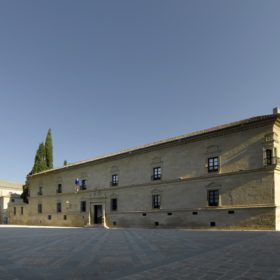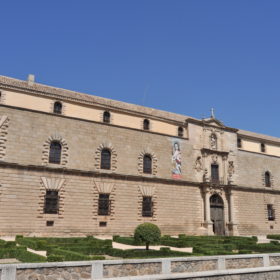Renaissance Architecture in 16th-Century Spain.
Introduction.
Renaissance architecture originated in Italy in the early 15th century, and was part of a much wider cultural phenomenon whereby secular humanism challenged the Medieval world view long dominated by the Catholic Church. The rediscovery of classical, pagan culture –Greek and especially Roman- opened up new vistas largely buried during the Middle Ages. In literature, for example, the Roman poet Ovid brought the world of mythology to life in his Metamorphoses, Virgil’s epic, the Aeneid, captures the heroic spirit of human endeavour in Aeneas’s journey to the founding of Rome, and Horace’s lyrical verse conveys common events and themes—love, the pleasures of friendship and the unpretentious life—with deceptive simplicity.
In architecture, impetus was provided by the rediscovery in 1414 of De Architectura by the Roman architect and engineer Marcus Vitruvius Pollio (c. 70 BC – 15 BC). This inspired the first Renaissance treatise on architecture, De re aedificatoria (On the Subject of Building) by Leon Battista Alberti in 1450. At the same time, the revival of the classical architecture of antiquity was facilitated by the fact that its remains were to be found everywhere in Italy and could be studied at first hand.
The result was the application of the general principles of classical architecture adapted to the conditions of 15th-century Italy. These principles were adjusted in turn to local situations as Italian influence spread throughout the rest of Europe. In Spain, for example, the popularity of plateresque surface ornamentation of Moorish inspiration and admiration for late Gothic flamboyance often resulted in buildings that were structurally Renaissance but adorned by a combination of plateresque and Gothic-inspired decoration.
Gothic and Renaissance Architecture.
At the time that Renaissance architecture first appeared, much of Europe was still dominated by Gothic architecture which in France and Spain had entered a stage called “flamboyant.” This involved lots of ornate and intricate details such as elaborate window tracery of curved lines imitating flames (from French flambe), perforated ornamental pinnacles, gargoyles, ogee arches, sophisticated ribbed vaulting etc. With almost all surfaces covered by some kind of intricate decoration, the impression is that of vibrancy or animation.
The contrast between the two styles of architecture was immediate. Renaissance architecture, inspired by classical Roman and Greek architecture, emphasized elegance, proportion, symmetry, order, just about everything Gothic was not at this time. In fact, the term “Gothic” was coined during the Renaissance by Italian humanists who considered the Goths barbarians responsible for the destruction of the classical culture of Rome and its empire. Gothic, then, became a derogatory term for bad taste and decadence when compared to the refinement of classical architecture.
The famous Gothic pointed arch for doorways and windows now gave way to framed rectangles or squares often topped by entablatures (horizontal beams resting on columns and made up of architrave, frieze and cornice) and/or triangular or curved pediments (see Section 3d). Arches were semicircular, and extensive use was made of classical columns (e. g. doric and ionic) and pilasters (shallow rectangular column projecting from a wall), which often divided walls into balanced sections. Sculptured figures were set in niches or placed on plinths.
In Spain, palaces, manor houses or villas frequently displayed heraldic devices such as escutcheons/shields or circular medallions placed in prominent locations as evidence of noble lineage or newly earned titles. Predictably, they appeared mostly above the main entrance, where they could hardly be missed. They also frequently straddled the corners of facades and adjoining side walls, where they could be viewed from more than one angle.
Renaissance Architecture in Spain.
Renaissance architecture entered Spain towards the end of the 15th century and coexisted with Gothic in Spain for a while. However, as the 16th century advanced, the Renaissance style became more dominant especially in the larger towns and cities.
In some instances, a change of taste might result in a building, initially designed or even starting as Gothic, to be later modified with Renaissance forms. One such example is the Gothic Palacio del Infantado, Guadalajara, north east of Madrid.

The Palacio was built from approximately 1480 to 1500 for a member of the powerful Mendoza family. Its striking façade combines Gothic architectural details with plateresque decorative features. Notable is the Gothic doorway with plateresque ornamentation. Prominent above it is the Mendoza coat of arms. The façade is covered by diamond stonework of the kind practiced by Mudéjar artisans (Mudéjar: Moor living under Christian rule in Spain). Still, the most impressive feature is the beautiful gallery of paired ogee Gothic windows interspersed with matching oriels (oriel: a kind of bay window) running along the top of the building. But modifications around 1570 saw the removal of the Gothic pinnacles that originally topped the façade. At the same time, Gothic windows were replaced by rectangular Renaissance windows, each with a triangular pediment above it. These design changes not only reflected a change in taste but possibly the desire to imitate a royal palace being built outside Madrid for Philip II.

The first Renaissance buildings to appear in Spain are generally considered to be the Colegio de Sta. Cruz (1483) in Valladolid and the Palacio de los Duques de Medinaceli c.1489 in Cogolludo (north east of Madrid).
The Colegio was commissioned by Cardinal Pedro González de Mendoza, the Palace by Luis de Cerda, first duke of the powerful Medinaceli family. Both buildings were designed by the same architect, Lorenzo Vázquez de Segovia (c. 1450-c. 1517), widely considered the first Spanish Renaissance architect although it is unclear whether he himself studied in Italy. However, both the Mendozas and the Medinacelis (in fact linked through marriage), were highly cultured and counted ambassadors, cardinals, poets in their families who were acquainted with Italy and the latest trends emanating from that country. Through them, Vázquez could have obtained sketches or treatises on architecture from Italy.
Both buildings hint at enduring Gothic and plateresque influence. Both have delicately worked balustrades and pinnacles that run along the top of the building, and the Palace has beautifully decorated windows on the upper level. In both instances, the attention given to the windows on the upper floor indicate the location of the grandest rooms.

Importantly, for both families, these early Renaissance works were indicators not only of their wealth, influence and power, but also established them as trail blazers of Renaissance artistic taste and the prestige that went with Italian cultural achievements.
The role played by the Mendoza and Medinaceli families in introducing Renaissance architecture into Spain is indicative of the influence of the nobility in directing the taste of the country at the time. While the Church had been at the forefront in expanding Romanesque and Gothic architecture, Renaissance building was spearheaded by nobility, royalty and the new wealthy in Spain.
For example, nobles such as Francisco de los Cobos and Juan Vázquez de Molina, both secretaries in turn to Charles V (ruled 1516-56), transformed the small Andalusian town of Ubeda into a jewel of Renaissance architecture.
To the west and within view of Ubeda, Baeza underwent a similar transformation at the same time and boasts a wealth of classical palaces. In 2003, the towns were jointly declared culturally and architecturally important World Heritage Sites by UNESCO, with the centre of Ubeda being ranked as “the greatest Renaissance architecture ensemble in Spain and one of the most important in Europe.”
The new wealthy were self-made men including those who had made their money in the newly conquered Americas (or Las Indias) and who, on returning, displayed their wealth commissioning large, imposing palaces in e. g. in Trujillo, Extremadura, the Palacio de los Duques de San Carlos, Palacio de la Conquista and the Palacio Juan Pizarro de Orellana.
The new architecture and its associated prestige also spread to public buildings, many sponsored by religious figures or nobles. Among these were hospitals (e. g. Santiago de Compostela 1501-11, Hospital de Tavera, Toledo, 1541, Hospital de Santiago, Ubeda 1562-75), universities (Alcalá de Henares, Osuna (Andalusia),1548, the Colegio del Patriarca Valencia 1586, and town halls (e. g. Seville 1527-34, Baeza,1559)
What may be surprising is the relatively few Renaissance cathedrals and churches, especially given the Church’s leading role in spreading Romanesque and Gothic architecture. Where we find most Renaissance churches is in Andalusia, and there is a historic reason for this: the presence of the Nasrid kingdom of Granada, the last enclave of the once powerful Muslim al-Andalus.
Granada remained a political factor in Spain controlling the area that made up most of modern Andalusia from the mid 13th century until its fall to the forces of Ferdinand and Isabella (the famous Catholic Monarchs) in 1492. Clearly, it was impossible to build churches in an area controlled by Islam, especially since Granada felt threatened by the close presence of its expansionist Christian neighbours. Predictably, once the conquest was over, the Christians set about stamping their presence by constructing what most distinguished them from the Muslims: their churches (although they also modified mosques).
Soon new Renaissance cathedrals or churches were raised in Antequera (1514), Córdoba’s choir in the middle of the Mosque (1523), Almería (1524), Jaén (1525), Granada (1528), Málaga (1528), Osuna (1534), Guadix (1549).
Elsewhere in Spain, there already existed a wealth of churches, especially Romanesque and Gothic, and where Renaissance churches did spring up, it was usually due to changing circumstances, e. g. in the 16th century, Valladolid’s 13th-century Gothic colegiata was elevated to a bishopric, which meant the need for a cathedral befitting the town’s status. In Trujillo, the 15th-century Iglesia de San Martín was modified in the 16th century to complement the numerous Renaissance mansions or palaces erected by returning “conquistadores” of America.
Despite the numerous secular classical palaces etc. erected in Spain and several impressive Renaissance cathedrals/ churches in Andalusia, there are two buildings that perhaps best define Renaissance architecture in 16th-century Spain, one in the first half of the century, the other in the second half. Both were initiated by monarchs, the first the royal palace of Charles V embedded in the Alhambra, Granada and begun in 1526, the second El Escorial, a palace-monastery-mausoleum commissioned by Philip II in 1563.
Images.
Guadalajara: Palacio del Infantado: https://commons.wikimedia.org/w/index.php?curid=21646728
Valladolid: Colegio de Sta.Cruz: By Jose Luis Filpo Cabana - Own work, CC BY 3.0, https://commons.wikimedia.org/w/index.php?curid=32280030
Cogolludo: Palacio de los Duques de Medinaceli:By Borjaanimal - Own work, CC BY-SA 4.0, https://commons.wikimedia.org/w/index.php?curid=48837710
Ubeda: San Salvador: By Heparina1985 - Own work, CC BY-SA 4.0, https://commons.wikimedia.org/w/index.php?curid=71236067
Ubeda: Palacio del Dean Ortega:By José Luis Filpo Cabana - Own work, CC BY 3.0, https://commons.wikimedia.org/w/index.php?curid=31515555
Ubeda: Palacio de las Cadenas: By Daniel Villafruela, CC BY-SA 3.0, https://commons.wikimedia.org/w/index.php?curid=17157531
Baeza: Palacio de Jabalquinto: De Michal Osmenda from Brussels, Belgium CC BY 2.0, https://commons.wikimedia.org/w/index.php?curid=24415616
Baeza: Town Hall: By Elisa.rolle - Own work, CC BY-SA 3.0 es, https://commons.wikimedia.org/w/index.php?curid=28047743
Baeza: Casa del Populo: By José Luis Filpo Cabana - Own work, CC BY-SA 4.0, https://commons.wikimedia.org/w/index.php?curid=71193317
Trujillo: Palacio de la Conquista: De Elemaki - Trabajo propio, CC BY 3.0, https://commons.wikimedia.org/w/index.php?curid=15826495
Trujillo: Palacio de los Duques de San Carlos: De José Luis Filpo Cabana - Trabajo propio, CC BY-SA 4.0, https://commons.wikimedia.org/w/index.php?curid=9574843
Trujillo: Palacio Juan Pizarro de Orellana: Alonso de Mendoza - https://es.wikipedia.org/wiki/Archivo:Palacio_Juan_Pizarro_de_Orellana,_Trujillo,_C%C3%A1ceres.jpg
Toledo: Hospital de Tavera: https://commons.wikimedia.org/wiki/File:Toledo_Capital_-_194_(37538222744).jpg
Alcala de Henares: University: By M.Peinado from Alcalá de Henares, España – 007194 CC BY 2.0, https://commons.wikimedia.org/w/index.php?curid=26523361
Seville: Town Hall: By Anual - Own work, CC BY-SA 4.0, https://commons.wikimedia.org/w/index.php?curid=64518307
Jaen: Cathedral: By PMRMaeyaert - Own work, CC BY-SA 4.0, https://commons.wikimedia.org/w/index.php?curid=47975266
Guadix: Cathedral: By Samu73 - Flickr (https://www.flickr.com/photos/samualpedrete/2692673885/), CC BY 2.0, https://commons.wikimedia.org/w/index.php?curid=4482248
Almeria: Cathedral: By Elena Martinez Chacon - Own work, CC BY-SA 3.0 es, https://commons.wikimedia.org/w/index.php?curid=35251829















